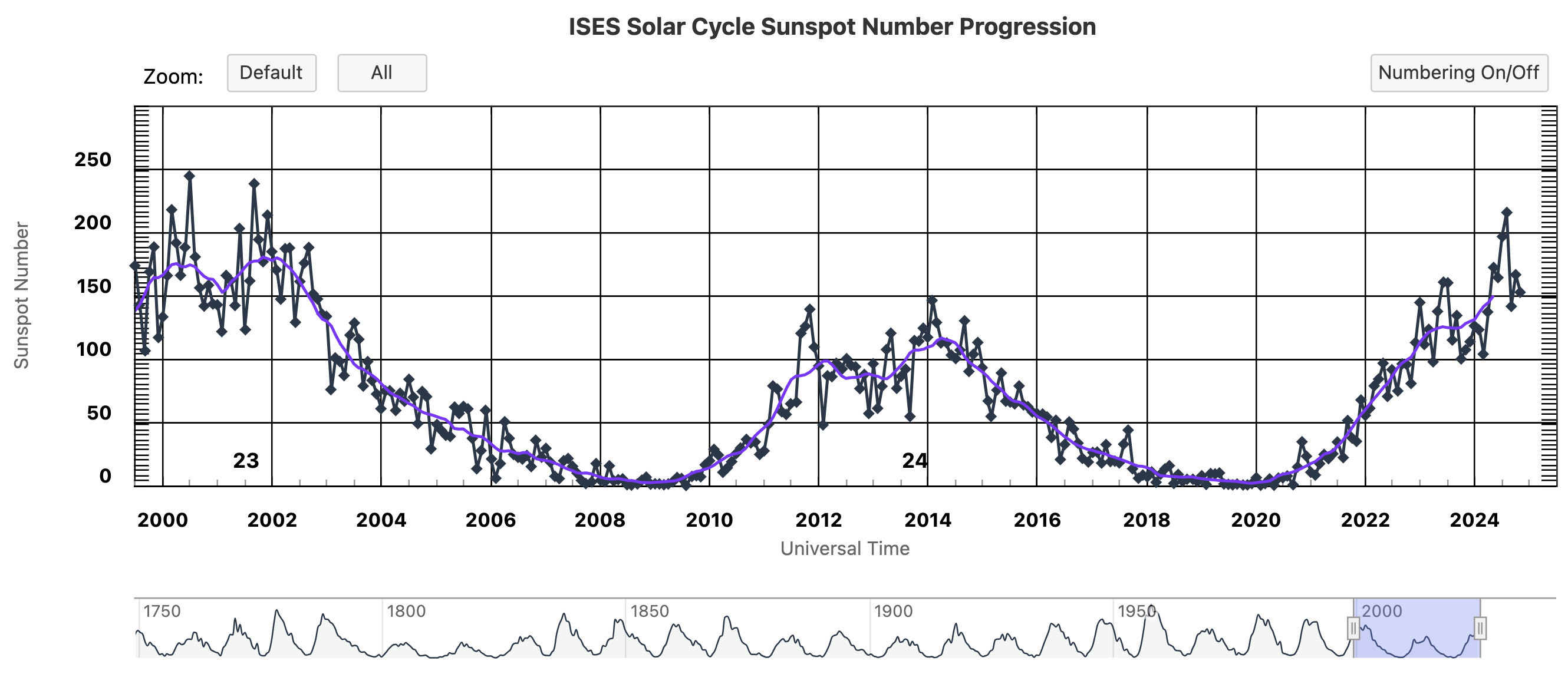2024 was a busy year for solar news, but what can we expect from 2025?
In April, a total solar eclipse was visible to millions in North America. This was followed in May by the largest geomagnetic storm for twenty years caused by successive coronal mass ejections (CMEs) that brought widespread northern and southern lights to low latitudes. This gave millions around the world their first view of the aurora.
In October, high levels of solar activity once again triggered a strong geomagnetic storm at Earth, offering another widespread display of low-latitude aurora. Following this event, NASA and NOAA announced in a joint press release that we are officially in the solar maximum period of the current solar cycle — Solar Cycle 25.
Understanding solar cycles
Solar activity rises and falls periodically over an 11-year solar cycle. Each cycle begins and ends during periods of low solar activity, with a peak of solar activity in the middle. The periods of low and high activity are called solar minimum and solar maximum respectively.
By historical definition, Solar Cycle 1 occurred between 1755 and 1766, placing the sun‘s current cycle in Solar Cycle 25. As of the end of 2024, we are firmly within the solar maximum period. However, the specific solar maximum is defined as the month with the highest 13-month smoothed sunspot number.
The smoothed sunspot value, represented as the purple line on the plot below (from NOAA’s Solar Cycle Progression website), differs from the black curve showing monthly sunspot measurements. Because the smoothed value is calculated as a 13-month rolling average, the latest data lags six months behind the current date. Thus, the specific solar maximum won’t be confirmed until many months — possibly a year — after it occurs. Because of this, and because it is impossible to know what sunspot numbers the next month will bring, we will not know when the specific solar maximum occurred until many months (perhaps a year) after.
What we do know is that Solar Cycle 25’s peak has already surpassed that of Solar Cycle 24, which peaked in 2014. This makes recent months the most active solar period since 2002, near the peak of Solar Cycle 23.
What’s ahead in 2025?

The sun treated us in 2024 to both a total solar eclipse and widespread auroras. Unfortunately, 2025 will not feature any total solar eclipses, though there will be partial eclipses in March and September, visible from parts of North America, Europe, and New Zealand. However, further opportunities for widespread aurora will be likely, as high solar activity continues.
Even if the solar maximum peak has passed (it may have but we wouldn’t know yet), 2025 will still be within the extended period of heightened solar activity around solar maximum. While exact levels of solar activity cannot be predicted, high sunspot numbers are anticipated, along with a higher likelihood of large solar flares and Earth-directed coronal mass ejections (CMEs). In 2024, an extreme G5 geomagnetic storm occurred in May, followed by a strong G4 storm in October. Another strong geomagnetic storm (G4 or above) is possible in 2025. However, these events can only be predicted 1–4 days in advance, based on the detection and speed of Earth-directed CMEs.
Historically, large solar flares and geomagnetic storms are more common in the declining phase after solar maximum. For instance, Solar Cycle 24 saw its largest solar flares (X13.3 and X11.9) three years after its 2014 maximum, in 2017. As of mid-December 2024, the strongest solar flare of Solar Cycle 25 was an X9.0 event on Oct. 3, 2024.
Larger flares have been observed by ESA’s Solar Orbiter spacecraft on the far side of the sun, but the Oct. 3 event remains the strongest detected by Earth-based instruments. Given the current strength of Solar Cycle 25, it is likely that even stronger flares may occur before the cycle concludes.
Related: Aurora activity is just getting started. Here’s why the best northern lights are yet to come.
Impact of solar activity
While 2024’s solar activity brought spectacular auroras, it also had downsides. During NASA and NOAA’s October briefing, it was revealed that May’s extreme geomagnetic storm disrupted satellite navigation systems, costing the U.S. farming industry — which relies heavily on automation — half a billion dollars. Additionally, the event strained power grids worldwide, though without major outages.
The previous extreme geomagnetic storm in 2003 caused damage to power grids in Sweden and South Africa. With heightened solar activity continuing into 2025, industries relying on satellites and power grids remain on high alert for potential solar impacts.
Article by:Source
























